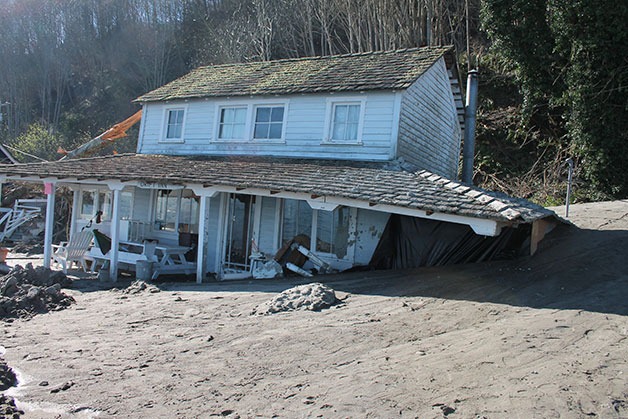A large slide of earth and trees crashed into a Clinton beachfront cabin, knocking it off its foundation and forcing Island County to restrict entry and occupancy.
In late February, a rush of mud, clay, water, trees and brush slid from a 200-foothigh bluff and down toward Puget Sound, wrecking one Campers Row Walk structure and filling another with sediment. Both are owned by the same family.
There were no injuries or fatalities from the slide.
The two buildings have since been red-tagged by county regulators, meaning they may not be entered for safety reasons. They belonged to the Wood family, siblings who were out of town when the mudslide occurred. Mud accumulated high enough to reach the bluffside eaves of the first story of the northern-most cabin.
“I haven’t dared go up there,” said owner Frances Wood, who writes The Record’s Whidbey Birding column.
“There’s been such a long history of family times there it’s frankly hard to imagine that that’s gone,” she added.
Island County restricted occupancy after a geotechnical expert reviewed the site Feb. 26. On Feb. 27, Island County posted the red tags on the exterior of the buildings, which are surrounded by an increasingly thick flow of sticky sediment. One neighbor, Peter Van Giesen, has regularly monitored the growth and measured it at six inches per day. Where there was once a yard there is now a shiny gray morass, slowly creeping toward the water. In spots, a trickle of sediment-rich water runs into the sea, streaking the beach with off-gray.
“This whole area is subject to slides,” said Bill Oakes, Island County Public Works director. “This is a steep, unstable bluff. When we get high groundwater, it tends to destabilize this. It’s all mapped as geohazard.”
This past December, a sudden slide after a particularly wet wind storm obliterated a cabin next door to the Woods and damaged the their building as well. The destroyed cabin’s wreckage remains covered with mud and scattered over the bulkhead toward the water.
The county issued notices to the beach homes from Hastings Road to 6106 Camper’s Row Walk that the bluff is “demonstrating higher than usual instability.” The cabin just south of the two red-tagged structures was given a yellow tag, limiting entry to daylight hours and only in short periods of time.
“It continues to move and we’ve cautioned everybody to stay away from these. … They continue to ooze,” Oakes said.
One of the Wood family’s cabins will need to have a structural evaluation if they wish to live there during the wet months, Oakes said. The building, though seemingly intact, is surrounded by mud and clay, and from outside the floors were covered in at least a foot of sediment.
“The force of nature is relentless,” said Van Giesen, who dealt with a landslide two decades ago at his walk-in community’s cabin.
“The very nature of the beach and the coast is it’s moving,” he added.



